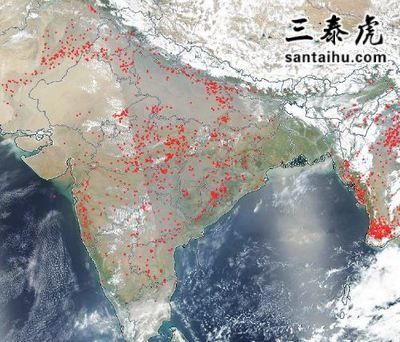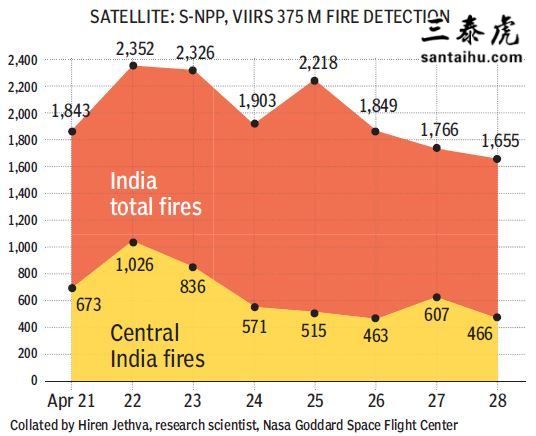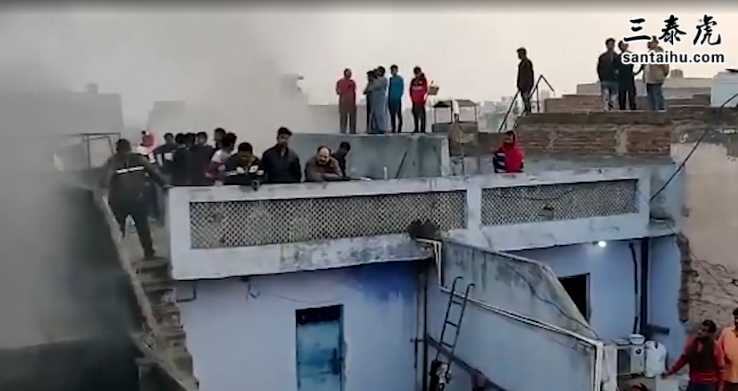Large parts of India dotted with fires: Nasa images
美国宇航局的图像显示印度境内到处都是星星之火

NEW DELHI: National Aeronautics and Space Administration (Nasa) images of the past ten days show large parts of India are dotted with fires, stretching across Uttar Pradesh (UP), Madhya Pradesh (MP), Maharashtra, Chhattisgarh and even some southern states. In sweltering summer, these fires are intensifying heat and causing black carbon (a component of soot with high global warming effect) pollution.
新德里:在过去十天里,美国国家航空航天局(Nasa)的图片显示,印度境内到处都是星星之火,从北方邦、马哈拉施特拉邦、马哈拉施特拉邦到恰蒂斯加尔邦,甚至还有南部的一些邦。在闷热的夏季,这些火灾加剧了高温,导致黑碳(一种会造成全球变暖的煤烟成分)污染。
Some of these dots may be forest fires but Hiren Jethva, research scientist at Nasa Goddard Space Flight Center, says fires in central India may be mostly crop fires as forest fires are usually uncontrolled and, therefore, produce more smoke and haze.
其中一些火点可能是森林大火,但美国航天局戈达德太空飞行中心的研究科学家海兰杰斯瓦说,印度中部的火情几乎都是焚烧秸秆引起的,因为森林大火通常不受控制,因此会产生更多的浓烟和雾霾。
Agricultural scientists are linking the massive rise in the incidence of crop fires in recent years to the dependence of farmers on combine harvesters, which leave a short stubble behind. The practice of crop stubble burning is not limited to the northern states of Haryana and Punjab, where the problem is rampant.
农业科学家们将近年来农作物火灾发生率的大幅上升与农民对联合收割机的依赖联系起来,联合收割机会在田地上留下短茬。焚烧秸秆的做法并不局限于哈里亚纳邦和旁遮普等北方各邦,不过那里的问题确实非常严重。
While burning of paddy stubble has been a common practice among farmers since it is unsuitable as fodder, increasing incidence of wheat stubble burning is a relatively new trend. States with crop fires seen in Nasa maps have a dominant rice-wheat crop system. There are two choices of harvesting for farmers—manual or by combine harvester. But with acute shortage of labour, combine harvesters are turning out to be the quickest and cheapest mode of harvesting and preparing the soil for paddy.
焚烧稻谷秸秆是农民的普遍做法,因为秸秆不适合作饲料,现在焚烧小麦秸秆的现象越来越多。在美国国家航空航天局(Nasa)地图上看到焚烧秸秆的各邦都是主要种植水稻的。农民收割作物有两种方式,一种是手工收割,另一种是联合收割机收割。但由于劳动力严重短缺,联合收割机成为了收割和平整稻田的最快捷、最便宜的方式。

According to Ridhima, crop stubble burning accounts for nearly 14 per cent of the country's black carbon emissions.
根据Ridhima的说法,在印度的炭黑排放中,燃烧农作物残茬的排放量占了近14%。
The highest number of fires is being seen in MP. About 10 farmers have already been detained this year in Sehore for burning wheat stubble that spread fire to nearby farms. Earlier in April, flames from stubble fire spread on almost 1,500 ha in Harda and Betul districts. A woman in the state died after catching fire in a farm.
在马哈拉施特拉邦这种焚烧点的数目最多。今年,希霍尔大约有10名农民焚烧秸秆,将火势蔓延到附近的农场而被拘留。今年4月早些时候,在哈达和贝图尔地区,焚烧秸秆的火焰蔓延了1500公顷。当地一名妇女因火势蔓延到农场而死亡。
来源:三泰虎 http://www.santaihu.com/44843.html
State's junior agriculture minister Balkrishna Patidar tells TOI, "We have been asking farmers to not burn crop residue as it is harmful not only for themselves, but also for the soil and environment. Still, the practice continues."
该邦的农业部长Balkrishna Patidar告诉《印度时报》:“我们一直要求农民不要焚烧秸秆,这不仅对他们自身有害,而且对土壤和环境也有害。但是,这种焚烧行为屡禁不止。”
There is no official data linking increase in combine harvester use with crop fires. But the Economic Survey 2018 highlights how farm mechanisation has increased tremendously. In 1960-61, about 93 per cent of farm power was from animate sources, which has reduced to 10 per cent now. Mechanical and electrical sources have increased from 7 per cent to 90 per cent.
目前还没有官方数据显示联合收割机与焚烧秸秆有关。但是,2018年的经济调查已经凸显了农业机械化的巨大增长。在1960年至1961年期间,约93%的农业动力来自于动物,但现在这一比例已降至10%。机械和电子资源已从7%增加到90%。
此文由 三泰虎 编辑,未经允许不得转载!:首页 > 印度 » 印度时报:美国宇航局的图像显示印度境内到处“星星之火”
 新德里北部一大楼发生火灾,造成43人死亡
新德里北部一大楼发生火灾,造成43人死亡 美国宇航局祝贺印度成功发射“月船2号”
美国宇航局祝贺印度成功发射“月船2号” 印度空间研究组织vs美国宇航局,印网友:美宇航局40%科学家是印度人
印度空间研究组织vs美国宇航局,印网友:美宇航局40%科学家是印度人 64克!美国宇航局发射印度男孩设计的世界最轻卫星
64克!美国宇航局发射印度男孩设计的世界最轻卫星 印度“一箭104星”,印网友:美国宇航局会失业的
印度“一箭104星”,印网友:美国宇航局会失业的 美国宇航局邀请印度联合探索火星,印网友:美国会拿走我们所有技术
美国宇航局邀请印度联合探索火星,印网友:美国会拿走我们所有技术 美国宇航局称计划未来几十年让人们生活在火星上
美国宇航局称计划未来几十年让人们生活在火星上